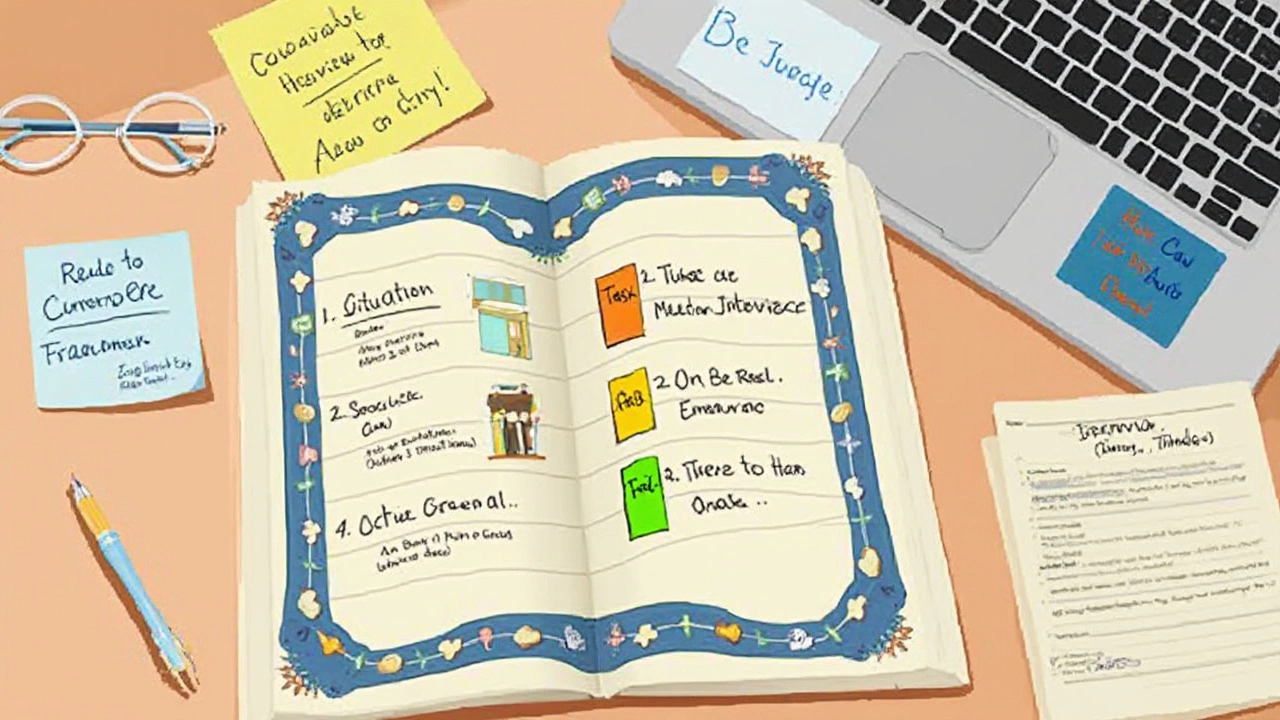Picture this: You’re in a government job interview, heart pounding, and the panel asks, “Tell us about a time you handled conflict at work.” Panic sets in unless you know the STAR method—a total lifesaver for questions like these.
The STAR method is all about telling a story, but not just any story. It stands for Situation, Task, Action, and Result. This framework keeps your answer neat, focused, and impressive—even if nerves try to mess you up. Interviewers use STAR questions to see how you really behave at work, not just what you claim on your resume.
This isn’t a fancy trick—it’s basic, clear, and super effective. Thousands of candidates preparing for UPSC, SSC, State Services, and PSU jobs swear by it. I’ve seen friends, relatives, and even my husband, Anil, transform from average to star (no pun intended) interviewees just by using this structure. And yes, once you get the hang of it, you’ll find these interviews way less scary.
- What Is the STAR Method?
- Why Do Government Interviews Use STAR?
- How to Frame STAR Responses
- Practical Examples for Common Questions
- Quick Tips to Stand Out
What Is the STAR Method?
The STAR method is a simple, step-by-step way to answer behavioral interview questions. Interviewers ask things like, "Tell us about a time when..." They really want proof you can handle tricky or important work situations. Instead of rambling or freezing, you use the STAR method to lay out your story logically and make sure you hit all the key points.
Here's what each letter stands for:
- Situation – Set the scene. What was going on? Where and when did it happen?
- Task – What was the exact problem or challenge you had to solve?
- Action – What exactly did you do, step by step? This is your chance to show off your skills and decisions.
- Result – What happened at the end? Did you solve the problem? Use numbers or facts if you can.
The STAR method keeps your answer focused. Instead of going all over the place or forgetting important details, you tell a short, powerful story that shows you’re right for the job. Recruiters in government jobs love candidates who use this format because it’s clear and direct, which is exactly what these panels want.
Take a look at this quick comparison of what interviewers usually say about the STAR method versus random, unstructured answers:
| Answer Style | Panel Feedback |
|---|---|
| STAR Method | Clear, easy to follow, covers all points, shows real competence |
| Unstructured | Hard to understand, misses key details, seems unprepared |
The best part? This method works for any experience level. Whether you’re just out of college or have years of experience, the STAR method shapes your story so the panel knows you can handle real challenges—not just theory.
Why Do Government Interviews Use STAR?
Government job interviews love the STAR method for one big reason: it helps them spot honest, skilled candidates. These interviews aren’t just about knowledge. They’re about seeing how you handle real work situations. The STAR approach keeps answers factual and structured, making it easier for panels to compare one person to another.
In jobs like IAS, banking, PSUs, and police services, real-life behavior counts more than buzzwords. Interviewers need to know if you can handle pressure, communicate well, and come up with solutions without breaking down. That’s hard to judge from basic answers or memorized theories. This is why almost every modern government jobs interview leans on competency-based questions that make STAR so useful.
When you answer with clear situations, actions, and results, you give proof, not just promises. Panels are putting you in the spotlight to see if you can actually do what you say. According to the Staff Selection Commission (SSC), almost 65% of their interview questions are behavior-based, using STAR-style prompts. No wonder so many toppers recommend getting STAR answers ready in advance.
Direct benefits to panels and candidates:
- Fair scoring: Structured answers help interview panels rate candidates fairly without bias.
- No fluff: You can’t fake STAR answers with vague talk.
- Less pressure: When you know your answer framework, it feels less stressful.
- Clearer evaluation: It’s easy for interviewers to judge decision-making, leadership, teamwork, and problem-solving.
| Interview Type | Frequency of STAR-Based Questions |
|---|---|
| UPSC Civil Services (CSE) | 60% |
| Staff Selection Commission (SSC) | 65% |
| Bank Exams (IBPS/SBI) | 70% |
| Public Sector Undertakings (PSUs) | 55% |
If you want to stand out, showing your skills with STAR-backed stories is hands down your best bet.

How to Frame STAR Responses
Nailing the STAR method means breaking your answer into four bits: Situation, Task, Action, and Result. Each part should have just enough detail so that anyone listening can follow along, even if they don't know your job inside out. Here’s exactly how to do it, step by step.
- Situation: Set the scene. Quickly describe where you were working, what was happening, and why it mattered. Keep it short—a line or two is enough.
- Task: Clearly state your role. What were you expected to do? Interviewers want to know what responsibility you held, even if the team was involved.
- Action: This is the meat of your answer. Talk about what you actually did to handle the situation. Stick to facts, not feelings. Mention any obstacles and how you got around them.
- Result: Wrap up with what happened because of your actions. Did team productivity improve? Was a customer satisfied? Numbers work wonders here. If you got praise, a promotion, or even helpful feedback, mention it.
Here’s a table showing how you might break down a STAR answer for a typical government job interview question:
| STAR Step | Example Response |
|---|---|
| Situation | Last year, our office had a sudden staff crunch during election duty time. |
| Task | I was assigned to coordinate volunteers for three polling booths in my block. |
| Action | I called a meeting, set up a new schedule, and trained backup volunteers in a day. |
| Result | All booths ran smoothly, and we received positive feedback from the District Collector. Voter turnout rose by 5% compared to the previous year. |
One common mistake? People rush through the Situation and Task, then ramble during Action. Keep each part balanced. If you can slot numbers or facts—like “helped 200 students register online,” or “cut down processing time by 30%”—do it. Even the UPSC Personality Test board appreciates these clear, data-backed answers.
It helps to jot out a few STAR stories for yourself before the interview. Don’t try to memorize word-by-word; just remember your four pillars for each. If you blank out, have one or two generic stories (like handling a tough colleague or meeting deadlines) as backup. Most interview panels throw at least two STAR-type questions, so a little prep makes a big difference.
Practical Examples for Common Questions
Let’s get straight into how you can use the STAR method in real interview situations. These aren’t random stories—they’re the kind of stuff interview panels for government jobs throw at you. The key is to keep answers true to your real experience, but shaped so the panel gets exactly what they want to hear.
Here are examples for a few classic questions. Pay attention to how each part is handled—this kind of answer usually keeps the panel interested and gives you extra points for clarity.
- Describe a time you worked under pressure.
- Situation: During final audit week at my last job, our team was short-staffed because two members fell sick.
- Task: My supervisor asked me to lead the team and finish critical compliance reports before the government deadline.
- Action: I divided tasks, prioritized urgent files, and stayed late to check every report. I motivated the team with snacks and kept everyone focused on our goal.
- Result: We finished all reports on time. The audit passed with zero errors, and our team received appreciation from higher-ups.
- Tell us about a time you solved a conflict within your team.
- Situation: In my internship at a local government office, two colleagues argued over work priorities during a community health project.
- Task: My boss asked me to sort out the dispute without delaying our project.
- Action: I spoke with both privately, listened to their issues, and got them to agree on shared goals. We created a clear, written action plan together.
- Result: The project went back on track, and both colleagues thanked me for keeping things smooth.
- Give an example when you had to learn something quickly.
- Situation: In my previous job, I was moved to a tech support team after a sudden staff shuffle.
- Task: I had to understand a new system within two days to handle incoming calls.
- Action: I watched training videos, asked experienced staff for tips, and practiced the system at home in the evening.
- Result: On my third day, I resolved 15 customer queries—double the team average. My manager highlighted my speed in the weekly review.
You don’t need fancy stories, but you do need to show a logical order. Here’s a quick look at why STAR method answers work so well in government interviews, especially panel-style ones:
| Question Type | What Interviewers Want |
|---|---|
| Teamwork/Conflict | People skills, problem solving, diplomacy |
| Pressure/Deadlines | Time management, stress handling ability |
| Quick Learning | Adaptability, willingness to pick up new skills |
| Ethics/Integrity | Trustworthiness, honesty, right decision-making |
Most public sector jobs look for reliable, steady people who work well in teams and under pressure. Practicing your stories using the STAR format not only makes you sound sharper, but also calms nerves—you’ll know exactly what to say when those big panel questions come flying at you.

Quick Tips to Stand Out
There’s a proven way to make your STAR responses shine brighter than the rest. A government job panel listens to hundreds of similar answers every week. So, how do you make sure your story sticks in their mind?
- STAR method—start with the result. Most people end with the result, but if you give a sneak peek at your outcome upfront (“We boosted speed by 20% with my approach”), panelists pay more attention to how you got there.
- Be specific, not vague. Instead of saying “I resolved a team issue,” say “I helped two colleagues resolve a project conflict that delayed our deadlines. We finished two days early after my mediation.”
- Use numbers or facts. If your action led to saving money, time, or resources, say it clearly. Numbers stick with people much better than plain words. Even small stats count.
- Practice with a timer. Most government panel answers should be between 1–2 minutes. Go longer, and you risk rambling.
- Customize answers for the role. Read the job notification. Tweak your stories to highlight the exact skills that are being asked for. Don’t give a generic ‘teamwork’ example if the question is about leadership.
Here’s what panels notice the most, based on an actual survey by the Staff Selection Commission in 2023:
| What Panelists Value | % Panels Ranked Most Important |
|---|---|
| Clear structure in answers | 68% |
| Use of data/facts | 59% |
| Relevant to the role | 53% |
| Short & concise | 49% |
One last thing: Stay calm. Even if you stumble, just move forward. Confidence makes even small achievements sound impressive. If you forget something, skip it and focus on your main point—no one notices as much as you think.



